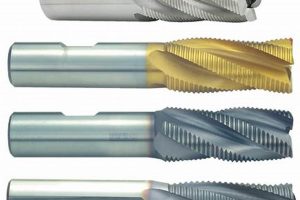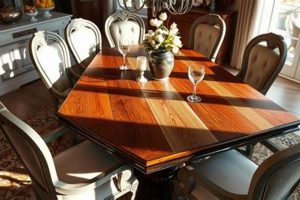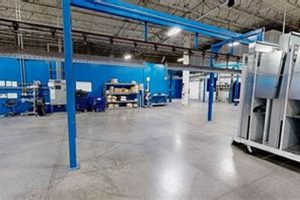The term denotes methods employed to add refined, aesthetically pleasing, and durable surfaces to various materials, often wood, metal, or textiles. These techniques encompass processes such as polishing, varnishing, staining, and applying decorative treatments to enhance the inherent characteristics of the base material. An exemplar includes the application of multiple coats of lacquer to a handcrafted wooden cabinet, resulting in a smooth, lustrous, and protective surface.
Such processes are valued for their ability to elevate the visual appeal and longevity of objects. They provide protection against wear, environmental factors, and degradation. Historically, these methods have been integral to craftsmanship, signifying quality and attention to detail, and often reflecting specific cultural and stylistic periods.
The subsequent sections will delve into specific techniques, materials, and applications associated with this field, exploring their evolution and impact on design and manufacturing.
Enhancing Longevity and Aesthetics
The following guidelines offer insights into achieving superior results in the application of refined surface treatments, emphasizing durability and visual appeal.
Tip 1: Material Selection is Paramount: The selection of appropriate materials, such as varnishes, stains, or sealants, must align with the substrate’s properties. Incompatible materials can lead to adhesion failures, discoloration, or premature degradation. For instance, oil-based varnishes are often preferred for hardwoods, while water-based acrylics are suitable for lighter-colored woods.
Tip 2: Surface Preparation is Critical: Thorough surface preparation, involving sanding, cleaning, and priming, is essential for optimal adhesion and a smooth, uniform appearance. Failure to properly prepare the surface can result in imperfections, such as bubbles, streaks, or uneven color absorption. Sanding should progress through increasingly finer grits to achieve a level surface.
Tip 3: Control Environmental Factors: Temperature and humidity levels significantly influence the drying and curing processes. Applying finishes in excessively humid or cold environments can lead to prolonged drying times, clouding, or cracking. Ideal conditions generally involve moderate temperatures and low humidity.
Tip 4: Apply Thin, Even Coats: Multiple thin coats are preferable to a single thick coat, as they promote better adhesion, reduce the likelihood of runs or sags, and facilitate even drying. Each coat should be allowed to dry completely before applying the next.
Tip 5: Utilize Proper Application Techniques: The choice of application method, whether brushing, spraying, or wiping, should be determined by the material, surface area, and desired finish. Proper technique minimizes brush strokes, spray patterns, or uneven distribution. Professional-grade brushes or spray equipment can significantly improve the outcome.
Tip 6: Consider Intermediate Sanding: Lightly sanding between coats, using fine-grit sandpaper, removes any imperfections or nibs, creating a smoother surface for subsequent layers. This step is particularly important when applying multiple coats of varnish or lacquer.
Tip 7: Allow Adequate Curing Time: Full curing, as opposed to simply drying, is crucial for achieving optimal hardness, durability, and resistance to chemicals or abrasions. Adhering to the manufacturer’s recommended curing times is essential. Premature use or handling can compromise the integrity of the surface.
These considerations underscore the importance of meticulous planning and execution in achieving surfaces that exhibit both lasting beauty and robust protection. Adherence to these principles will result in superior outcomes.
The subsequent section will discuss common challenges and troubleshooting techniques encountered during these processes.
1. Surface Preparation
Surface preparation forms the foundational element of processes aiming for high-quality, durable surfaces. It directly impacts the adhesion, appearance, and longevity of any applied finish, thereby determining the overall success of the endeavor.
- Cleaning and Degreasing
The removal of contaminants such as dirt, oil, grease, and wax is paramount. These substances inhibit proper adhesion, resulting in imperfections like fisheyes or peeling. For instance, prior to varnishing wooden furniture, a thorough cleaning with mineral spirits ensures the absence of residues that could compromise the finish’s integrity.
- Sanding and Smoothing
Sanding levels the surface, removes imperfections such as scratches or dents, and creates a profile that promotes mechanical adhesion. Progressing through increasingly finer grits is crucial for achieving a consistently smooth base. Consider the preparation of metal surfaces for painting; initial coarse sanding removes rust, followed by finer grits to achieve a suitable surface for primer and subsequent paint layers.
- Priming and Sealing
Primers and sealers create a uniform surface, improving adhesion and preventing the absorption of finish into the substrate. They also provide a barrier against corrosion or staining. Applying a wood sealer before staining prevents uneven color absorption, ensuring a consistent and professional outcome.
- Repairing Imperfections
Addressing imperfections, such as cracks, holes, or chips, prior to finishing is essential for a flawless outcome. Filling these defects with appropriate fillers or putties ensures a uniform surface that enhances the overall aesthetic. Examples include patching nail holes in woodwork before painting or repairing chips in furniture before applying a protective coating.
These facets highlight the crucial role of meticulous surface preparation in attaining durable and visually appealing surfaces. Inadequate preparation invariably leads to compromised aesthetics and premature failure of the applied finish. These steps provide the foundation upon which techniques are built, allowing for the achievement of superior results.
2. Material Compatibility
The enduring success of many refined surface treatments hinges on a critical principle: material compatibility. This addresses the synergistic relationship between the substrate and the materials applied to it, such as paints, stains, varnishes, and adhesives. Mismatches in material properties often lead to detrimental effects, including adhesion failure, cracking, discoloration, or accelerated degradation of the treated surface. For example, applying a rigid epoxy coating to a flexible substrate like leather will likely result in the coating cracking under minimal stress. Conversely, using a water-based stain on an oily wood without proper preparation can result in uneven color absorption and a blotchy appearance.
The significance of material compatibility extends beyond mere aesthetics; it directly influences the longevity and protective qualities of the surface treatment. Selecting materials with similar expansion and contraction coefficients minimizes stress caused by temperature fluctuations, preventing premature wear. Consider the marine industry, where specialized paints and coatings are engineered for compatibility with specific hull materials (e.g., aluminum, fiberglass) to resist corrosion and fouling in harsh saltwater environments. In furniture restoration, matching the type of finish to the original material and construction techniques ensures that the restoration is not only visually appealing but also structurally sound and enduring.
In essence, careful consideration of material compatibility is an indispensable aspect of surface refinement. Ignoring this principle compromises both the visual appeal and the functional integrity of the finished product. By understanding and applying the appropriate materials to a given substrate, practitioners can achieve surfaces that are not only aesthetically pleasing but also resistant to the damaging effects of time and the environment. Understanding this interrelationship is vital for achieving enduring, high-quality outcomes in this field.
3. Application Techniques
Proficient execution of processes is inextricably linked to the attainment of visually refined and durable surfaces. The methods employed directly influence the final appearance, uniformity, and protective qualities of any applied finish, regardless of the materials used. Mastery of these techniques is therefore paramount to achieving the hallmarks of such processes.
- Brushing Techniques
The application of coatings via brushing necessitates precise control over brushstroke direction, pressure, and overlap. Improper brushing can result in visible brush marks, uneven coating thickness, and air entrapment. Consider the application of varnish to a wooden surface; employing long, even strokes, following the grain, minimizes streaking and ensures uniform coverage. Conversely, haphazard brushing leads to a substandard appearance and compromised protection.
- Spraying Methods
Spraying, whether airless, HVLP (High Volume Low Pressure), or conventional, demands expertise in nozzle selection, pressure regulation, and spray pattern control. Inadequate technique produces runs, sags, orange peel texture, or overspray. For instance, automotive painting relies heavily on skilled spraying to achieve a flawless, mirror-like finish. Incorrect settings or technique results in an unacceptable surface requiring extensive correction.
- Wiping and Padding
Wiping and padding techniques, commonly used for stains, oils, and glazes, require careful control over application pressure, material saturation, and removal timing. Improper technique can result in blotchy color, uneven sheen, or residue buildup. Applying an oil-based stain to wood, for example, involves wiping off excess material to reveal the grain while achieving a uniform color. Failure to do so results in dark, obscured grain patterns.
- Surface Preparation Integration
The effectiveness of any application technique is fundamentally dependent on prior surface preparation. Even the most skilled application will fail to yield optimal results on a poorly prepared surface. Contaminants, imperfections, or inadequate sanding create barriers to proper adhesion and uniform appearance. Sanding and priming are crucial precursors to achieving a flawless result.
The preceding points highlight that skilled application techniques are not merely procedural steps but integral components in producing high-caliber results. Mastery of these skills, coupled with meticulous attention to surface preparation, underpins the attainment of surfaces characterized by aesthetic refinement and lasting protection. Ineffective or improperly executed application compromises the potential of even the finest materials. It underscores the fact that expertise in technique is as important as the quality of the products being used.
4. Environmental Control
Environmental control plays a pivotal role in processes aimed at achieving refined, durable surfaces. Temperature, humidity, and air quality are primary factors influencing the outcome of coating applications. Fluctuations or deviations from optimal environmental conditions can directly compromise the adhesion, drying, curing, and overall integrity of the applied finish. For instance, excessive humidity during the application of water-based coatings can impede evaporation, leading to prolonged drying times, clouding, or even blistering. Conversely, excessively dry conditions can cause rapid solvent evaporation in solvent-based coatings, resulting in poor flow, brush marks, and a compromised final appearance. Dust and airborne particles introduce contaminants that disrupt the smooth surface, thus impacting visual quality and longevity.
The importance of environmental control is particularly evident in specialized contexts such as automotive refinishing and furniture restoration. In automotive painting, precise temperature and humidity regulation within spray booths are crucial for achieving the flawless, high-gloss finishes demanded in the industry. Similarly, museum conservators employ climate-controlled environments when treating delicate artifacts to prevent damage from moisture or temperature fluctuations. Implementing effective environmental controls often involves using specialized equipment, such as dehumidifiers, humidifiers, air filtration systems, and temperature-controlled booths. The selection and operation of this equipment require a thorough understanding of the specific requirements of the coatings being applied and the substrate being treated.
Ultimately, environmental control is not merely an ancillary consideration, but an integral component of the process. Implementing precise measures to manage temperature, humidity, and air quality is essential for minimizing defects and ensuring the long-term performance of surfaces. A comprehensive understanding of the interplay between environmental factors and coating behavior is therefore crucial for practitioners seeking to achieve consistently high-quality results. Failure to address these variables can result in costly rework, compromised product quality, and reduced durability, undermining the overall value and effectiveness of the entire endeavor.
5. Curing Process
The curing process represents a critical phase in procedures, directly influencing the durability, hardness, chemical resistance, and overall performance characteristics of the completed surface. This process, involving chemical reactions that cross-link polymers within the applied coating, transforms a liquid or semi-liquid film into a solid, protective layer. The efficacy of this transformation fundamentally dictates the long-term success of the endeavor. For instance, the thorough curing of a catalyzed varnish on a fine wood surface is paramount for achieving the hardness and solvent resistance expected of such a finish, whereas inadequate curing would leave the surface soft, easily scratched, and vulnerable to damage from common household chemicals. Similarly, the complete curing of powder coatings on metal substrates ensures the long-term corrosion protection and impact resistance essential for industrial applications.
Varied coating types necessitate different curing mechanisms, each requiring specific conditions to proceed effectively. Air-drying coatings rely on solvent evaporation and oxidation, demanding ample ventilation and controlled temperatures to facilitate proper film formation. Two-component epoxy systems require precise mixing ratios and adherence to specified induction times to ensure complete cross-linking. UV-cured coatings, commonly used in high-speed manufacturing processes, necessitate exposure to specific wavelengths and intensities of ultraviolet light to initiate polymerization. Deviations from recommended curing parameters often lead to compromised finish properties, such as reduced gloss, poor adhesion, or increased susceptibility to environmental degradation. The process of lacquer application, a hallmark of many processes, requires proper curing time to achieve its characteristic hardness and clarity. Rushing this phase will result in a soft, easily marred surface.
In summary, the curing process is not merely a passive stage but an active component inextricably linked to the quality and longevity of a surface. Understanding the specific curing requirements of different coating types, adhering to recommended conditions, and implementing appropriate monitoring techniques are essential for realizing surfaces that meet the stringent demands of high-quality craftsmanship. Inadequate attention to curing invariably undermines the entire process, leading to diminished aesthetics, reduced functionality, and ultimately, a substandard final product. The commitment to precise execution of the curing process is a hallmark of professionals dedicated to achieving excellence in this field.
Frequently Asked Questions
The following addresses common inquiries regarding processes, aiming to clarify fundamental concepts and dispel misconceptions.
Question 1: What distinguishes processes from modern alternatives?
Traditional methods emphasize hand craftsmanship and utilize natural materials, often resulting in unique textures and nuanced aesthetics. Modern techniques prioritize speed, uniformity, and cost-effectiveness, frequently relying on synthetic materials and automated processes.
Question 2: What are the primary benefits of opting for surfaces over contemporary options?
Processes offer enhanced durability, repairability, and aesthetic appeal. They often exhibit a depth and richness of character unattainable through modern, mass-produced finishes. Additionally, they are frequently more environmentally sustainable, utilizing renewable resources and minimizing waste.
Question 3: What types of substrates are best suited for surfaces?
Processes are typically applied to solid wood, metal, and leather. The choice of technique and materials must align with the specific properties of the substrate to ensure compatibility and optimal results.
Question 4: How does one ensure longevity for an object with a surface?
Maintaining such surfaces requires regular cleaning with appropriate products, protection from direct sunlight and extreme temperature fluctuations, and prompt repair of any damage. Periodic reapplication of protective coatings may also be necessary.
Question 5: What are the most common challenges encountered during such processes?
Challenges include achieving consistent color matching, ensuring proper adhesion, managing drying times, and mitigating environmental factors. These challenges necessitate meticulous attention to detail and adherence to established best practices.
Question 6: How does one determine the appropriate process for a specific project?
The selection of appropriate processes depends on factors such as the substrate material, desired aesthetic, intended use, and budget constraints. Consulting with an experienced professional is recommended to ensure optimal results.
In summation, processes represent a commitment to quality, durability, and timeless aesthetics. While they may require greater skill and effort than modern alternatives, the resulting surfaces offer unparalleled beauty and longevity.
The subsequent section will delve into case studies illustrating successful implementation of specific techniques.
Conclusion
This exploration has outlined the core elements integral to understanding “classic finishing”: material selection, surface preparation, application techniques, environmental control, and the curing process. Each of these facets demands meticulous attention and a comprehensive understanding to achieve enduring and aesthetically refined surfaces. The historical context and ongoing relevance within various industries have also been emphasized.
The pursuit of excellence in surface treatment requires not only knowledge of these processes but also a commitment to continuous learning and refinement of skills. The preservation and appropriate application of these enduring techniques ensures a legacy of quality and craftsmanship for future generations. Continued research and thoughtful adaptation will be critical in maintaining the value and relevance of “classic finishing” in an evolving technological landscape.





![Status Check: Is Ragna Crimson Manga Finished [Spoiler Alert!] Best Final Touch: Elevate Your Projects with Professional Finishing Status Check: Is Ragna Crimson Manga Finished [Spoiler Alert!] | Best Final Touch: Elevate Your Projects with Professional Finishing](https://bestfinaltouch.com/wp-content/uploads/2025/12/th-666-300x200.jpg)

